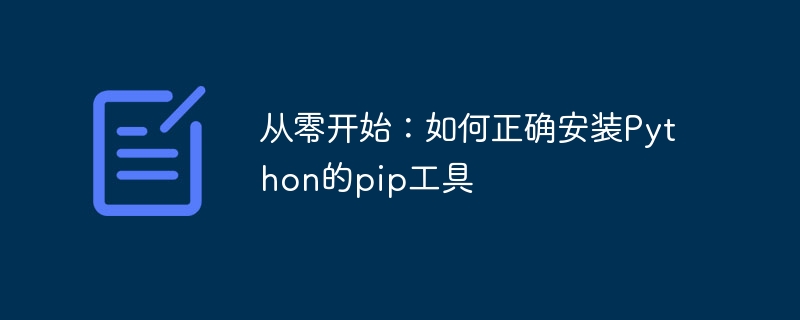

Starting from scratch: How to correctly install Python’s pip tool
Python is a powerful programming language that is widely used in data analysis, machine learning, website development, etc. field. Pip is Python's package management tool, used to install, upgrade and uninstall Python libraries. This article will introduce how to correctly install Python's pip tool, as well as some specific code examples.
Step 1: Check Python version
First, make sure you have the latest version of Python installed. Open a terminal or command prompt and run the following command to check the Python version:
python --version
If you have installed Python, the Python version number will be displayed. If Python is not installed, please install Python first and check whether the installation is successful.
Step 2: Download the pip installation script
The pip tool is released with Python, so you can find the pip installation script on Python's official website. Open the browser and visit https://pip.pypa.io/en/stable/installing/ to download the installation script.
Step 3: Run the pip installation script
In the terminal or command prompt, enter the directory where the installation script is located, and run the following command to install pip:
python get-pip.py
This command will Run the installation script and install pip to the default installation path of Python.
Step 4: Verify pip installation
After the installation is complete, run the following command to verify whether pip is successfully installed:
pip --version
If you see the version number of pip, then pip has been successfully installed. .
Step 5: Use pip to install the Python library
Now you can use pip to install and manage the Python library. Here are some common pip command examples:
Installing the library:
pip install <库名>
For example, to install the numpy library, run the following command:
pip install numpy
View installed libraries:
pip list
This command will list all libraries installed in the current Python environment and their version numbers.
Upgrade library:
pip install --upgrade <库名>
For example, to upgrade the numpy library, run the following command:
pip install --upgrade numpy
Uninstall the library:
pip uninstall <库名>
For example, to uninstall the numpy library, run the following command:
pip uninstall numpy
Summary:
Through the above steps, you have successfully installed the Python pip tool, and Learned how to use pip to install, upgrade and uninstall Python libraries. The powerful function of the pip tool allows you to easily manage and use various Python libraries and improve development efficiency.
Note: When installing Python libraries, it is recommended to use a virtual environment to isolate the dependencies of different projects to avoid library version conflicts. You can use the virtualenv tool or the venv module that comes with Python to create and manage virtual environments.
I hope this article will help you correctly install the pip tool of Python, and I wish you happy programming in the world of Python!
The above is the detailed content of Python Beginner's Guide: Learn to install the pip tool correctly. For more information, please follow other related articles on the PHP Chinese website!




